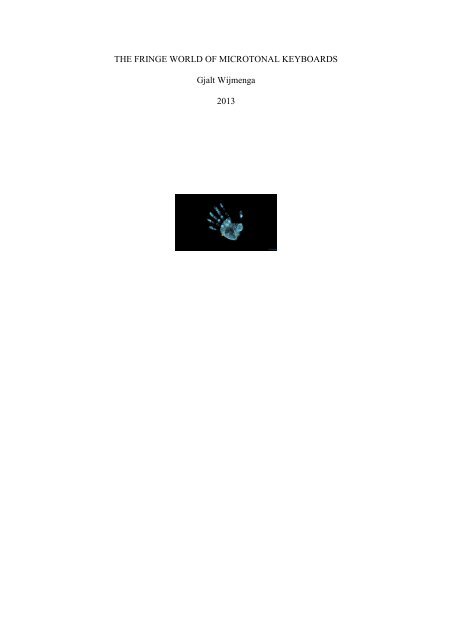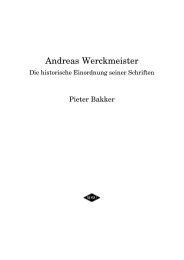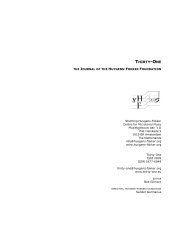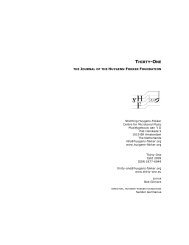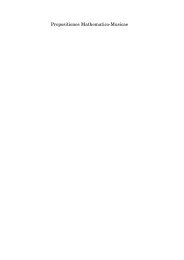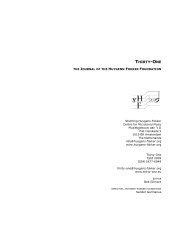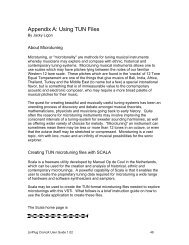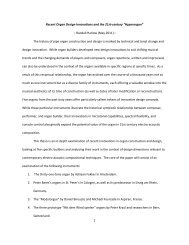the fringe world of microtonal keyboards - Stichting Huygens-Fokker
the fringe world of microtonal keyboards - Stichting Huygens-Fokker
the fringe world of microtonal keyboards - Stichting Huygens-Fokker
You also want an ePaper? Increase the reach of your titles
YUMPU automatically turns print PDFs into web optimized ePapers that Google loves.
THE FRINGE WORLD OF MICROTONAL KEYBOARDS<br />
Gjalt Wijmenga<br />
2013
Contents<br />
1 Introduction<br />
1 A. Microtonality<br />
1 B. Just Intonation<br />
- 1 Definitions and deductions; intervals and mutual coherence<br />
- 5 Just Intonation keyboard concepts<br />
6 C. From geometric mean to equal temperament.<br />
- 6 Discrimination<br />
- 7 Meantone<br />
- 7 Equal temperament<br />
9 D. Keyboards<br />
- 9 Classification <strong>of</strong> keyboard designs according to various criteria<br />
- 9 Generalized <strong>keyboards</strong><br />
- 17 Distinguishing key colours<br />
- 22 Comparison between keyboard designs<br />
- 24 Resolution<br />
25 Epilogue<br />
Without <strong>the</strong> help <strong>of</strong> Siemen Terpstra I would not have been able to put everything I intend to<br />
publish about <strong>microtonal</strong> <strong>keyboards</strong> into just English. I want to thank Siemen for his<br />
assistance, also concerning his suggestion to add some <strong>the</strong>oretical references to mean tone<br />
tunings.
Introduction<br />
In this treatise I want to pay attention to this issue: which minimal means are needed to<br />
express <strong>the</strong> max. Are 12 keys per octave sufficient to express tonal 5-limit music? And if not,<br />
how many keys are needed per octave? And what about 7-limit music? And so on.<br />
The <strong>world</strong> <strong>of</strong> keyboard music instruments is indeed a <strong>fringe</strong> <strong>world</strong>, and this has always been<br />
that way throughout <strong>the</strong> centuries. A keyboard as a part <strong>of</strong> music instruments is a rational<br />
concept which is peculiar to human beings, while acoustic instruments in general reflect<br />
something <strong>of</strong> nature, that is to say <strong>the</strong> animal kingdom. A wind instument has a similarity<br />
with <strong>the</strong> vocal chords. Strings are comparable to <strong>the</strong> way crickets produce <strong>the</strong>ir sound. Beat<br />
instruments resemble <strong>the</strong> heartbeat and also <strong>the</strong> way some monkeys beat <strong>the</strong>ir chests.<br />
A. Microtonality<br />
At first sight it comes to <strong>microtonal</strong>ity when intervals are smaller than <strong>the</strong> "semitone", which<br />
can be defined as <strong>the</strong> tempered semitone in 12 e.t. Here <strong>the</strong> criterion is a keyboard instrument<br />
with 12 keys per octave, apart from <strong>the</strong> tuning system that is applied.<br />
But let us assume that music from <strong>the</strong> renaissance period is played on a 31-tone organ. In this<br />
case it is true that <strong>the</strong> 31-tone organ is a <strong>microtonal</strong> instrument, but our perception is that this<br />
music is not <strong>microtonal</strong>. This leads us to <strong>the</strong> music idiom as a possible criterion with relation<br />
to <strong>microtonal</strong>ity. Then it is obvious that we define music up to and including 5-limit as non<strong>microtonal</strong><br />
and from 7-limit (to infinite) as <strong>microtonal</strong>. In a 7-limit music idiom we find <strong>the</strong><br />
diesis (36/35, 49/48, 64/63) as a micro-interval, but also 7/6 and 8/7, and <strong>the</strong>se intervals are<br />
definitely larger than <strong>the</strong> "semitone", but not accurately playable on a 12-tone keyboard<br />
instrument. After all, 7- limit ( and 11-, 13- and so on) music can not be accurately played by<br />
a 12-tone keyboard instrument. So, <strong>the</strong> shift is between 5- and 7-limit.<br />
Lastly, we can consider tuning systems with tempered intervals. It is a fact that <strong>the</strong> quotient<br />
(pure interval) / (tempered interval) is equal to a micro-interval. Based on this given it is<br />
possible to define any tempered tuning system as being <strong>microtonal</strong>. But this is a mere<br />
<strong>the</strong>oretical consideration that doesn't play an important role in musical practice.<br />
Thus we can distinguish <strong>the</strong> following definitions <strong>of</strong> <strong>the</strong> concept "<strong>microtonal</strong>ity":<br />
- 1. Keyboard instruments with more than 12 keys per octave<br />
- 2. Extension <strong>of</strong> music idiom from (3-,) 5-limit to 7- (11-, 13- and so on) limit.<br />
- 3. All tuning systems that deviate from just intonation, whe<strong>the</strong>r <strong>the</strong>y are non-cyclic or<br />
cyclic, irregular or regular.<br />
B. Just Intonation<br />
Definitions and deductions; intervals and mutual coherence<br />
Pure intervals are formed by <strong>the</strong> ratio’s <strong>of</strong> frequencies, which can be described by simple<br />
whole positive numbers. From number 1 as point <strong>of</strong> departure we are able to arrange <strong>the</strong>se<br />
whole positive numbers in a multidimensional continuum existing <strong>of</strong> vectorial directions <strong>of</strong><br />
prime numbers. Every direction exists <strong>of</strong> an exponential row <strong>of</strong> intervals, i.e. interval stacks:<br />
(a/b) n . When we assume b = 1, we achieve: (a/1) n = a n<br />
1
We are able to investigate interval relations by two-dimensional sections.<br />
As a first plan prime number 2 on horizontal axis:<br />
9<br />
3 6 12<br />
1 2 4 8 16<br />
Fig. a<br />
From number 1 using as departure number 3 is <strong>the</strong> following number in this order <strong>of</strong> whole<br />
numbers forming a new vectorial direction. This configuration <strong>of</strong> numbers can also be<br />
depicted as follows:<br />
Fig. b<br />
8<br />
4 12<br />
2 6 18<br />
1 3 9 27<br />
Figures a and b are depicted by a logarithmic scale, i.e. equal distance in case <strong>of</strong> involution.<br />
Considering two triangles adjacent to each o<strong>the</strong>r in a 2-dimensional section (matrix) <strong>of</strong> <strong>the</strong><br />
infinite universe <strong>of</strong> whole numbers, as shown in fig. a and fig. b, we discover that <strong>the</strong> product<br />
<strong>of</strong> <strong>the</strong> numbers on <strong>the</strong> communal side <strong>of</strong> <strong>the</strong> triangles is equal to <strong>the</strong> product <strong>of</strong> <strong>the</strong> numbers <strong>of</strong><br />
<strong>the</strong> angles which are on a line perpendicular to <strong>the</strong> communal side. In <strong>the</strong> matrix this <strong>the</strong>sis is<br />
valid for any pair <strong>of</strong> mutual identical triangles with one communal side, i.e. in case <strong>of</strong> two<br />
triangles which are explainable by a 180 degrees rotation.<br />
N.B.: It is also possible to consider 3-dimensional sections when 3 perpendicular dimensions<br />
represent vectors <strong>of</strong> prime numbers, for example 3, 5 and 7. Pr<strong>of</strong>. A.D. <strong>Fokker</strong> made use <strong>of</strong><br />
this (according to Euler); <strong>the</strong> octave is omitted and fifths / fourths, major thirds / minor sixths,<br />
minor thirds / major sixths, and <strong>the</strong> intervals related to prime number 7 can be depicted<br />
graphically.<br />
The internal connections between intervals also can be shown by <strong>the</strong> following genealogical<br />
tree based on <strong>the</strong> octave interval, by which <strong>the</strong> division <strong>of</strong> intervals by arithmetic mean is<br />
apparent.<br />
etcetera<br />
01 : 02<br />
02 : 03 : 04<br />
04 : 05 : 06 : 07 : 08<br />
08 : 09 : 10 : 11 : 12 : 13 : 14 : 15 : 16<br />
16 : 17 : 18 : 19 : 20 : 21 : 22 : 23 : 24 : 25 : 26 : 27 : 28 : 29 : 30 : 31 : 32<br />
Fig. c<br />
2
There also exists a tree based on <strong>the</strong> octave, by which <strong>the</strong> division <strong>of</strong> <strong>the</strong> intervals by ano<strong>the</strong>r<br />
mean than <strong>the</strong> arithmic one can be shown.<br />
½ : 1<br />
¼ : 1/3 : ½<br />
1/8 : 1/7 : 1/6 : 1/5 : ¼<br />
1/16:1/15:1/14:1/13:1/12:1/11:1/10:1/9:1/8<br />
1/32:1/31: 1/30:1/29:1/28:1/27:1/26:1/25:1/24:1/23:1/22:1/21:1/20:1/19:1/18:1/17:1/16<br />
etcetera<br />
Fig. d<br />
The means <strong>of</strong> <strong>the</strong> intervals, thus found, we call harmonic.<br />
When we compare figures c and d, we distinguish two mutual mirrored patterns. In <strong>the</strong> first<br />
case <strong>the</strong> octave is divided in subsequently fifth and fourth, and in <strong>the</strong> second case <strong>the</strong><br />
following order is reversed, i.e. subsequently fourth and fifth. For <strong>the</strong> division <strong>of</strong> o<strong>the</strong>r<br />
intervals like <strong>the</strong> fifth, <strong>the</strong> fourth, etc. <strong>the</strong> same kind <strong>of</strong> reversal is valid.<br />
When we converge both trees, <strong>the</strong>n we can conceive all intervals as being divided in two<br />
ways, i.e. by <strong>the</strong> arithmic mean and by <strong>the</strong> harmonic mean. The relation <strong>of</strong> harmonic mean<br />
and arithmic mean is also an interval. So, when we take a given interval as a starting point, we<br />
are able to derive three more intervals from this interval. This given is important when we<br />
think <strong>of</strong> an imaginary construction <strong>of</strong> a generalized keyboard, which will be discussed in<br />
section D <strong>of</strong> this treatise. This imaginary construction can be considered as derived from a<br />
projection <strong>of</strong> interval stacks in a logarithmic scale on <strong>the</strong> planimetry <strong>of</strong> a keyboard, thus<br />
expressing only pure intervals. In <strong>the</strong> case <strong>of</strong> <strong>the</strong> octave we achieve only Pythagorean<br />
intervals, 3-limit.<br />
From a given interval or ratio three o<strong>the</strong>r intervals can be derived. In order to define <strong>the</strong>se<br />
intervals I propose that we use already existing musicological terms and to generalize <strong>the</strong>se.<br />
This means that, when we take for example <strong>the</strong> octave as <strong>the</strong> interval, we define <strong>the</strong> fifth as<br />
major and <strong>the</strong> fourth as minor, and <strong>the</strong> Pythagorean whole tone as <strong>the</strong> leading tone interval.<br />
The same when we take any o<strong>the</strong>r interval as a starting point:<br />
interval = major . minor; leading tone = major / minor.<br />
In ma<strong>the</strong>matical formula:<br />
interval = (x² + x)(x² – x) = (x + 1)(x – 1)<br />
arithmetic mean = x²<br />
harmonic mean = (x² - 1)<br />
major = x/(x-1) or (x²+x)/(x²-1)<br />
minor = (x+1)/x or (x²-1)/(x²-x)<br />
leading-tone-interval = x²/(x² - 1)<br />
3
Subsequently we can occupy ourselves with <strong>the</strong> question concerning how many times a<br />
leading tone interval fits within a major or a minor. Which value does <strong>the</strong> exponent <strong>of</strong> <strong>the</strong><br />
leading tone interval have? The inductive method gives us an answer to our question:<br />
major: x<br />
minor: x – 1<br />
This implies that, when <strong>the</strong> exponent exceeds <strong>the</strong> values found, <strong>the</strong> result will extend <strong>the</strong><br />
(value <strong>of</strong> <strong>the</strong>) interval. The exponential stacks <strong>of</strong> <strong>the</strong> leading tone interval and <strong>the</strong>ir relation to<br />
<strong>the</strong> interval from which <strong>the</strong> leading tone interval is derived is essential to <strong>the</strong> approach <strong>of</strong> this<br />
treatise. The amount <strong>of</strong> leading tone intervals within <strong>the</strong> interval is equal to x + ( x – 1) =<br />
2x – 1. When we take <strong>the</strong> octave (= 2/1) as a starting point, <strong>the</strong> leading tone interval ( = 9/8)<br />
will appear 2 . 3 – 1 = 5 times within <strong>the</strong> octave, just below 6 times! The interval (9/8) 5 =<br />
1,802032470703125 …. and (9/8) 6 = 2, 027286529541015625…; in <strong>the</strong> first case smaller<br />
than 2/1 and in <strong>the</strong> second case bigger than 2/1.<br />
The exact way to determine <strong>the</strong> number <strong>of</strong> leading tone intervals within an interval is equal to:<br />
log interval / log leading tone interval. The result will extend <strong>the</strong> value <strong>of</strong> 2x - 1.<br />
The amount <strong>of</strong> times that a Pythagorean whole tone fits within an octave is:<br />
5,884919236171185509743480647783… i.e. <strong>the</strong> amount <strong>of</strong> times a Pythagorean whole tone<br />
can be depicted within an octave in logarithmic scale.<br />
Besides <strong>the</strong> conclusion that (2x – 1) leading tone intervals fit into a given interval, it has to be<br />
pointed out that <strong>the</strong> depiction <strong>of</strong> <strong>the</strong>se leading tone intervals within this given interval is such<br />
that two rows can be distinguished. After all, when we consider <strong>the</strong> harmonic mean <strong>of</strong> an<br />
interval, we can define it as <strong>the</strong> starting point <strong>of</strong> a row <strong>of</strong> leading tone intervals, in which <strong>the</strong><br />
arithmetic mean is also included; in addition <strong>the</strong> beginning <strong>of</strong> a given interval is starting point<br />
<strong>of</strong> a row <strong>of</strong> leading tone intervals. Both rows overlap each o<strong>the</strong>r like (ro<strong>of</strong>)tiles when we<br />
depict <strong>the</strong>se as a diagram on logarithmic scale (see section D Keyboards). Because <strong>of</strong> this we<br />
can define <strong>the</strong> notion “row” in <strong>the</strong> scope <strong>of</strong> a planimetry: a row is a succession <strong>of</strong> adjacent<br />
keys which indicate leading tone intervals. All o<strong>the</strong>r successions <strong>of</strong> adjacent keys are defined<br />
as columns. Both rows and columns represent different vectorial directions in <strong>the</strong> planimetry<br />
<strong>of</strong> a keyboard.<br />
The planimetry <strong>of</strong> a keyboard is determined by only <strong>the</strong>se two givens alone, i.e. <strong>the</strong> number <strong>of</strong><br />
leading tone intervals within a given interval and two adjacent parallel rows <strong>of</strong> keys, thus<br />
forming <strong>the</strong> succession <strong>of</strong> leading tone intervals in logarithmic scale.<br />
A number <strong>of</strong> planimetry’s can be derived from various x values:<br />
- x=3 octave<br />
- x=4 major sixth<br />
- x=5 fifth<br />
and so on.<br />
4
Just Intonation keyboard concepts<br />
It is imaginable - but not necessarily preferable! - to make music in just intonation by<br />
generalized <strong>keyboards</strong> because planimetry’s based on different x-values can be seen as<br />
sections <strong>of</strong> <strong>the</strong> multidimensional continuum <strong>of</strong> prime numbers. A planimetry with x-value 3<br />
is based on two vectorial directions <strong>of</strong> <strong>the</strong> prime numbers 2 and 3, so 3-limit music<br />
(Pythagorean scale) can be played on a keyboard that is designed in accordance with this<br />
planimetry. The planimetry’s with x-values 3, 4 and 5 are sufficient for (generalized)<br />
keyboard designs in order to express <strong>the</strong> whole range <strong>of</strong> 5-limit music in just intonation. This<br />
is valid <strong>of</strong> course when <strong>keyboards</strong> <strong>of</strong> different designs based on <strong>the</strong> x values 3, 4 and 5 are<br />
played simultaneously. This issue <strong>of</strong> just intonation <strong>keyboards</strong> reminds us <strong>of</strong> <strong>the</strong> voice<br />
harmonium <strong>of</strong> Colin Brown, <strong>the</strong> organ <strong>of</strong> Henry Ward Poole, and o<strong>the</strong>r concepts. These were<br />
not generalized <strong>keyboards</strong> because <strong>the</strong> keys are <strong>of</strong> different shape, though all <strong>the</strong> keys <strong>of</strong> <strong>the</strong><br />
same shape and in <strong>the</strong> same pattern in <strong>the</strong>se designs form toge<strong>the</strong>r a regularity that is<br />
compatible with <strong>the</strong> concept <strong>of</strong> a generalized keyboard. The concept <strong>of</strong> <strong>the</strong> generalized<br />
keyboard will be elaborated in section D. So, in <strong>the</strong> just intonation keyboard designs <strong>of</strong> Colin<br />
Brown, Henry Ward Poole and o<strong>the</strong>rs it looks like more than two dimensions coincide in one<br />
level, as if several generalized <strong>keyboards</strong> are integrated in one design. This is valid for all just<br />
intonation concepts like for example <strong>the</strong> Enharmonic Organ <strong>of</strong> Thomas Perronet Thompson,<br />
<strong>the</strong> Organ <strong>of</strong> Henry Liston, <strong>the</strong> pure scale harmonium (39-tone scale) <strong>of</strong> Harry Partch, <strong>the</strong><br />
Semantic, a just intonation keyboard by Alain Daniélou, <strong>the</strong> Enharmonic Pipe Organ in 7-<br />
limit just intonation by Martin Vogel, <strong>the</strong> Wilson/Daoud just intonation keyboard. All <strong>the</strong>se<br />
keyboard designs are still irregular.<br />
Fig. e. Harry Partch’s 43-tone scale on <strong>the</strong> Tonal Plexus: it looks kind <strong>of</strong> regular, but it isn't.<br />
That is to say, this concept is not in conformity with <strong>the</strong> definition <strong>of</strong> a generalized keyboard<br />
(section D: Keyboards)<br />
5
Fig. f Explanation <strong>of</strong> <strong>the</strong> pitches in Harry Partch’s 43-tone scale on <strong>the</strong> Tonal Plexus<br />
C. From geometric mean to equal temperament<br />
Discrimination<br />
The ability to distinguish intervals from each o<strong>the</strong>r by ear is closely interwoven with <strong>the</strong><br />
concept <strong>of</strong> resolution, which I will elaborate fur<strong>the</strong>r in section D about keyboard designs. The<br />
smaller <strong>the</strong> intervals are <strong>the</strong> more difficult <strong>the</strong>y are to discriminate. So, we can imagine that<br />
<strong>the</strong> number <strong>of</strong> <strong>the</strong> small intervals that are used in musical practice is limited.<br />
Besides <strong>the</strong> fact that <strong>the</strong> smaller <strong>the</strong> interval becomes <strong>the</strong> harder it is to distinguish, <strong>the</strong>re also<br />
exists ano<strong>the</strong>r point <strong>of</strong> view, i.e. <strong>the</strong> confusion that might arise when 3-limit intervals are<br />
compared with 5-limit intervals, 5-limit intervals with 7-limit intervals, and so on.<br />
For example <strong>the</strong> Pythagorean third compared with <strong>the</strong> pure major third, respectively 64/81<br />
and 64/80. The quotient <strong>of</strong> both intervals = 1,265625/1,25 = 1,0125.<br />
Ano<strong>the</strong>r example is <strong>the</strong> augmented major sixth compared with <strong>the</strong> 7-limit interval 7/4. The<br />
augmented major sixth we find by multiplying <strong>the</strong> major sixth with <strong>the</strong> chromatic semitone, as<br />
follows: 5/3.25/24 = 125/72 = 1,7361111. So, <strong>the</strong> quotient <strong>of</strong> <strong>the</strong> 7/4 interval and <strong>the</strong><br />
augmented major sixth = 1,75/1,7361111 = 1,008.<br />
When we augment a Pythagorean whole tone, like Ab-B in <strong>the</strong> harmonic scale <strong>of</strong> C, we<br />
achieve 9/8.25/24 = 1,171875. This interval is near by <strong>the</strong> 7-limit interval 7/6. The difference<br />
we find by calculating <strong>the</strong> quotient <strong>of</strong> both intervals, as follows: 1,171875/1,166666 =<br />
1,0044648.<br />
The differences become smaller and smaller.<br />
There is, <strong>of</strong> course, an infinite number <strong>of</strong> <strong>the</strong>se kinds <strong>of</strong> NEO’s or NEA’s, so to speak, when<br />
we extend music from 3-limit to 5-limit, from 5-limit to 7-limit, and so on.<br />
Besides all this, discrimination <strong>of</strong> intervals is possible by <strong>the</strong> musical context in which<br />
intervals play a role. When, for example, chords are played, we are able to conclude that pure<br />
major thirds are meant instead <strong>of</strong> Pythagorean thirds. And so on.<br />
6
Mean tone<br />
A mean tone is <strong>the</strong> geometric mean <strong>of</strong> an interval. As soon as pure major thirds (5/4) are<br />
recognized in polyphonic music, <strong>the</strong> difference between <strong>the</strong> major whole tone (9/8) and <strong>the</strong><br />
minor whole tone (10/9) is experienced as problematic. Especially for keyboard instruments.<br />
In order to solve this problem <strong>the</strong> mean tone temperament is developed as a compromise.<br />
Actually <strong>the</strong>re exists a variety <strong>of</strong> different mean tone temperaments. The main idea in <strong>the</strong>se<br />
mean tone temperaments is a line <strong>of</strong> (unequal) tempered fifths that takes <strong>the</strong> geometric mean<br />
<strong>of</strong> all major thirds, apart from <strong>the</strong> size <strong>of</strong> <strong>the</strong> major third.<br />
Equal temperament<br />
The idea <strong>of</strong> meantones is generalized into <strong>the</strong> concept <strong>of</strong> an equal temperament when an<br />
octave is divided to equal steps. Any interval can now be seen as <strong>the</strong> geometric mean <strong>of</strong><br />
ano<strong>the</strong>r interval.<br />
The 31 e.t. as proposed by <strong>Huygens</strong> is close to <strong>the</strong> 1/4 syntonic comma mean tone<br />
temperament with regard to <strong>the</strong> pitch.<br />
A 12 e.t. can also be seen as a meantone related temperament, i.e. 1/11syntonic comma<br />
meantone temperament.<br />
There exist e.t.’s in which <strong>the</strong> major whole tones (9/8) and <strong>the</strong> minor whole tones (10/9) can<br />
be distinguished from each o<strong>the</strong>r, for example 41 e.t. and 53 e.t. These e.t.’s are not related to<br />
mean tone temperaments and <strong>the</strong>y form a different family <strong>of</strong> equal temperaments.<br />
Comparison in cents <strong>of</strong> pure intervals with tempered intervals <strong>of</strong> 12 e.t., 19 e.t., 31 e.t.<br />
and 53 e.t. in <strong>the</strong> following list:<br />
Octave = log 2 . 1200 / log 2 =1200.<br />
12 e.t.: 1200 cents<br />
19 e.t.: 1200 cents<br />
31 e.t.: 1200 cents<br />
53 e.t.: 1200 cents<br />
Fifth = log 3/2 . 1200 / log 2 = 701,95500086538741774437001806814 cents<br />
12 e.t.: 700 cents<br />
19 e.t.: 694, 73684210526315789473684210526 cents<br />
31 e.t.: 696, 77419354838709677419354838709 cents<br />
53 e.t.: 701, 88679245283018867924528301887 cents<br />
Fourth = log 4/3 . 1200 / log 2 = 498, 04499913461258225551326726344 cents<br />
12 e.t.: 500 cents<br />
19 e.t.; 505, 26315789473684210526315789474 cents<br />
31 e.t.: 503, 22580645161290322580645161290 cents<br />
53 e.t.: 498, 11320754716981132075471698113 cents<br />
7
Major third = log 5/4 . 1200 / log 2 = 386,3137138648348174443833153879 cents<br />
12 e.t.: 400 cents<br />
19 e.t.: 378, 94736842105263157894736842105 cents<br />
31 e.t.: 387, 09677419354838709677419354839 cents<br />
53 e.t.: 384, 90566037735849056603773584906 cents<br />
Minor third = log 6/5 . 1200 / log 2 = 315,64128700055260030010341735063 cents<br />
12 e.t.: 300 cents<br />
19 e.t.: 315, 789473684210526315778947368421 cents<br />
31 e.t.: 309, 677419354838709677419354838709 cents<br />
53 e.t.: 316, 981132075471698113207547169811 cents<br />
Second (whole tone) = log 9/8 . 1200 / log 2 = 203,91000173077483548897346547509<br />
cents (major)<br />
or log 10/9 . 1200 / log 2 = 182,40371213405998195540984991281<br />
cents (minor)<br />
12 e.t.: 200 cents<br />
19 e.t.: 189, 47368421052631578947368421053 cents<br />
31 e.t.: 193, 54838709677419354838709677419 cents<br />
53 e.t.: 203,77358490566037735849056603774 cents<br />
or 181,13207547169811320754716981132 cents<br />
Diatonic semitone = log 16/15 . 1200 / log 2 = 111, 73128526977776481112995 cents<br />
12 e.t.: 100 cents<br />
19 e.t.: 126, 31578947368421052631578947368 cents<br />
31 e.t.: 116, 12903225806451612903225806452 cents<br />
53 e.t.: 113, 20754716981132075471698113208 cents<br />
Chromatic semitone = log 25/24 . 1200 / log 2 = 70, 672426864282217144279898037272<br />
cents<br />
12 e.t.; 100 cents<br />
19 e.t.: 63, 157894736842105263157894736842 cents<br />
31 e.t.: 77, 419354838709677419354838709677 cents<br />
53 e.t.: 67, 924528301886792452830188679245 cents<br />
7/6-interval = log 7/6 x 1200 / log 2 = 266, 87090560373751118587644794125 cents<br />
31 e.t.: 270, 96774193548387096774193548387 cents<br />
53 e.t.: 271, 6981132075471 6981132075471698 cents<br />
8/7-interval = log 8/7 x 1200 / log 2 = 231, 17409353087507106963681932218 cents<br />
31 e.t.: 232, 25806451612903225806451612903 cents<br />
53 e.t.: 226, 41509433962264150943396226415 cents<br />
8
D. Keyboards<br />
Classification <strong>of</strong> keyboard designs according to various criteria<br />
Difference in playability<br />
- 3- / 5- / 7-limit music polyphonically playable: just intonation in 3-limit<br />
or 12- 19- 31 e.t.; 41- 53 e.t. etc.: i.e. tuning systems based on 1 row / circle <strong>of</strong> fifths.<br />
- 3- / 5- / 7-limit music not (or at least: less) polyphonically playable: multiples <strong>of</strong><br />
12, such as 24 e.t., 96 e.t., etc.: i.e. tuning systems based on multiple circles <strong>of</strong> fifths.<br />
Keyscapes<br />
- relief, for example shaped by white and black keys on 12 e.t. repetitively placed in<br />
linear arrangement as well as elevation plan as introduced by Bosanquet in case <strong>of</strong><br />
planimetric configuration <strong>of</strong> keys (generalized keyboard)<br />
- colour patterns in just intonation as well as in equal or unequal temperaments<br />
Play modes in general:<br />
- linear: 12-tone keyboard, just like flute and o<strong>the</strong>r wind instruments, harp<br />
- planimetric: generalized <strong>keyboards</strong>, just like string instruments such as violin, guitar,<br />
cymbalon<br />
Generalized keyboard<br />
Definition: all keys are identical in shape, and <strong>the</strong> arrangement <strong>of</strong> keys follows a regular<br />
pattern.<br />
Consequently pure tuning is out <strong>of</strong> <strong>the</strong> question, except for 3-limit for a given configuration <strong>of</strong><br />
keys, which is possible for x = 3.<br />
Therefore <strong>the</strong> tunings are equal or unequal tempered, with <strong>the</strong> aim <strong>of</strong> creating polyphonic<br />
music, which is 5-limit as a rule.<br />
Fig. g. Von Janko Keyboard<br />
The simplest examples are button accordion and Janko keyboard, both for 12 e.t.<br />
Bosanquet is <strong>the</strong> founder <strong>of</strong> <strong>the</strong> generalized keyboard for tunings different from 12 e.t.<br />
9
Generalized <strong>keyboards</strong> are suitable for<br />
1. just intonation (to a limited extent) or<br />
2. tuning systems that deviate from just intonation, i.e.<br />
- both unequal temperaments, like for example Werckmeister,<br />
- and equal temperaments.<br />
In <strong>the</strong> vision <strong>of</strong> Gert Vos, who designed a <strong>microtonal</strong> keyboard that can be tuned in both<br />
31 e.t. and 53 e.t., <strong>the</strong> underlying concept <strong>of</strong> a (generalized) keyboard tuned in one equal<br />
temperament is not a two-dimensional plane, a planimetry, like we have seen in section B, but<br />
<strong>the</strong> surface <strong>of</strong> a cylinder. When we make a drawing <strong>of</strong> one octave block in one equal<br />
temperament we have a limited number <strong>of</strong> keys which form toge<strong>the</strong>r a group like in fig. j on<br />
page 12, fig. l on page 14, and fig. n on page 16. When we bend such a group <strong>of</strong> keys around<br />
a cylinder in such a way that <strong>the</strong> keys <strong>of</strong> <strong>the</strong> upper row touch <strong>the</strong> ones <strong>of</strong> <strong>the</strong> lower row in a<br />
logical way, we achieve a continuity <strong>of</strong> (tempered) interval stacks around a cylinder, running<br />
continuously in <strong>the</strong>ir specific directions round <strong>the</strong> surface <strong>of</strong> <strong>the</strong> cylinder without ending.<br />
It is <strong>of</strong>ten said that equal temperaments are “cyclic” tuning systems. But this is not quite true.<br />
In <strong>the</strong> vision <strong>of</strong> Vos <strong>the</strong>re are no cycles or circles, only spirals. One simple example can make<br />
this clear to us. When we envision a row <strong>of</strong> fifths in 12 e.t., we know that this row <strong>of</strong> twelve<br />
fifths runs through seven octaves. The row ends on <strong>the</strong> same meridian where it starts, that is to<br />
say when we envision meridians on <strong>the</strong> surface <strong>of</strong> a cylinder that run parallel with <strong>the</strong> axis <strong>of</strong><br />
<strong>the</strong> cylinder. In <strong>the</strong> case octaves are horizontal, i.e. parallel with a meridian on <strong>the</strong> cylinder<br />
surface, like <strong>the</strong> Terpstra keyboard, octave blocks are juxtaposed parallel with <strong>the</strong> cylinder<br />
axis. On <strong>the</strong> Vos keyboard <strong>the</strong> octaves run in a spiral, which is about similar to <strong>the</strong> <strong>Fokker</strong><br />
keyboard design.<br />
Out <strong>of</strong> what is explained in section B about <strong>the</strong> mutual coherence <strong>of</strong> intervals, a variety <strong>of</strong><br />
planimetry’s can be constructed. The properties <strong>of</strong> each <strong>of</strong> <strong>the</strong>se planimetry’s leads us, much<br />
to our surprise, to <strong>the</strong> combination <strong>of</strong> equal temperaments suitable for each <strong>of</strong> <strong>the</strong>se<br />
planimetry’s. The specific combinations <strong>of</strong> equal temperaments on each <strong>of</strong> <strong>the</strong>se planimetry’s<br />
also guarantee invariance with regard to <strong>the</strong> intended intervals played on <strong>the</strong> keyboard. The<br />
finger positions will always remain <strong>the</strong> same. On <strong>the</strong> contrary, one famous example <strong>of</strong> lack <strong>of</strong><br />
invariance is Bosanquet’s generalized keyboard design. His design is recommended for <strong>the</strong><br />
same pattern <strong>of</strong> keys as suitable for both 31 e.t. and 53 e.t., which would cause invariance to<br />
be lost, if applied simultaneously on <strong>the</strong> same planimetry, i.e. on <strong>the</strong> same keyboard.<br />
Designs for generalized <strong>keyboards</strong> can be related to <strong>the</strong> planimetry's as sections <strong>of</strong> <strong>the</strong><br />
multidimensional continuum <strong>of</strong> prime numbers for x-values 3, 4, 5 (and so on) as indicated in<br />
section B Just Intonation. We deduce which combination <strong>of</strong> equal temperaments is applicable<br />
for one <strong>of</strong> <strong>the</strong> planimetry´s, in such a way that any intentioned interval to be played on a<br />
keyboard will always be played on <strong>the</strong> same keys. In which case we speak <strong>of</strong> invariance.<br />
For <strong>the</strong> various keyboard designs based on different planimetry´s <strong>the</strong> combinations <strong>of</strong> equal<br />
temperaments (i.e. divisions per octave) are as follows:<br />
- x = 2: (3, 2) 5, 7, 12, 19, 31, etc.<br />
- x = 3: (5, 7) 12, 19, 31, 50, etc. and also 43, 55...<br />
- x = 4: (13, 9) 22, 31, 53<br />
- x = 5: (15, 19) 34, 53, etc. and also 72 ...<br />
and so on.<br />
10
Fig. h Planimetry x = 3 including numerical indications for possible equal temperaments.<br />
The generalized keyboard designs related to <strong>the</strong> x = 3 planimetry are by Robert Bosanquet,<br />
Adriaan <strong>Fokker</strong>, Anton van de Beer, Erv Wilson, and Siemen Terpstra.<br />
The equal temperaments that are applicable here never make possible a distinction between<br />
<strong>the</strong> major whole tone (9/8) and <strong>the</strong> minor whole tone (10/9). So, <strong>the</strong>se groups <strong>of</strong><br />
temperaments we call mean tone related. This is even so true for 12 e.t.<br />
11
Fig. i Terpstra keyboard: <strong>the</strong> first working prototype.<br />
The hexagonal shape <strong>of</strong> <strong>the</strong> key combined with <strong>the</strong> elevation plan is evident. Terpstra's<br />
design combines features <strong>of</strong> both Erv Wilson and Robert Bosanquet.<br />
The traditional music notation fits very well on <strong>keyboards</strong> that are designed in conformity<br />
with <strong>the</strong> planimetry with x-value 3. See fig. j below:<br />
Fig. j Music notation on 31 keys per octave, suitable for: 1. Pythagorean scale in just<br />
intonation, 2. Unequal temperaments like mean tone, Werckmeister and o<strong>the</strong>rs, 3. Equal<br />
temperaments that are mean tone related.<br />
Music notation can also be extended as is proposed by Adriaan <strong>Fokker</strong>. In his notation system<br />
more accidentals are introduced like half sharps and half flats. This can be valuable for<br />
example in case <strong>of</strong> expressing 7-limit music idiom when all kind <strong>of</strong> weird intervals will be<br />
used. This is an area to be explored fur<strong>the</strong>r.<br />
12
Fig. k Planimetry x = 4; <strong>the</strong> numbers indicate <strong>the</strong> possible e.t.’s within <strong>the</strong> major sixth.<br />
Fur<strong>the</strong>r deduction leads to octave divisions: both 31 e.t. and 53 e.t.<br />
13
Fig. l Vos keyboard based on planimetry x = 4 (fig. k), and comparable with<br />
<strong>the</strong> plan <strong>of</strong> J.P. White for 53 e.t. as published in Helmholtz’ book “Sensation <strong>of</strong> tone”.<br />
A spectacular feature <strong>of</strong> this design is <strong>the</strong> easy way to recognize <strong>the</strong> composition <strong>of</strong> a fourth<br />
by <strong>the</strong> intervals 7/6 and 8/7, only by <strong>the</strong> way <strong>the</strong> keys are arranged. In fig. l <strong>the</strong> equal steps in<br />
53 e.t. are shown by numbers. The fourth is 22 steps. The 7/6 interval is 12 steps, and <strong>the</strong><br />
interval 8/7 is 10 steps, toge<strong>the</strong>r forming a diësis. Fur<strong>the</strong>rmore, rows <strong>of</strong> 7/6 form interval<br />
stacks (7/6) n which resemble slendro scale, and also a horizontal 3/1 ~ (7/6) 7 .<br />
14
Fig. m Planimetry x = 5 enclosing <strong>the</strong> range <strong>of</strong> a fifth<br />
15
The Hanson keyboard can be related to <strong>the</strong> x = 5 planimetry.<br />
Fig. n Hanson keyboard with diagonal rows <strong>of</strong> chromatic semitones, each 3 steps in 53 e.t.<br />
Because <strong>of</strong> <strong>the</strong> 53 e.t. tuning it is obvious that <strong>the</strong> Hanson keyboard can be compared with <strong>the</strong><br />
Vos keyboard. It is not immediately clear if <strong>the</strong> Hanson keyboard may have some advantages<br />
above <strong>the</strong> Vos keyboard. Research and experiment (experience) will be needed.<br />
16
Distinguishing key colours<br />
The differences in key colours as we are used to are based upon tonality concepts. The white<br />
keys on a 12 e.t. keyboard express both a major scale and a minor scale. The remaining keys<br />
are black, though some organs or harpsichords have <strong>the</strong>se colours exchanged. The remaining<br />
black keys form toge<strong>the</strong>r a pentatonic scale, which refers to an original 3-limit Pythagorean<br />
tuning.<br />
Fig. o Example <strong>of</strong> colour pattern for mean tone related temperaments on Bosanquet's<br />
keyboard design. The colours white and black indicate respectively <strong>the</strong> sharps and <strong>the</strong> flats <strong>of</strong><br />
<strong>the</strong> keys belonging to <strong>the</strong> middle row <strong>of</strong> greenish keys. (N.B.: Green is <strong>the</strong> (symbolic) colour<br />
<strong>of</strong> <strong>the</strong> middle; bluish is distant and yellowish near by.) From top to bottom 7 – 5 - 7 - 5 – 7.<br />
This 31-tone octave block is suitable for 12 e.t., 19 e.t., 31 e.t. and eventually 43 e.t.<br />
The most obvious solution for mean tone related temperaments seems to be a colour pattern<br />
existing <strong>of</strong> a repetitive alteration <strong>of</strong> 7 – 5 - 7 – 5 - 7, etc. Colour patterns based on <strong>the</strong> matrix<br />
model do not make sense because in mean tone related temperaments <strong>the</strong>re is no comma shift.<br />
17
Fig. p Artist impression <strong>of</strong> one octave block <strong>of</strong> <strong>the</strong> compact keyboard <strong>of</strong> Terpstra, with same<br />
colour pattern as on fig. o. Suitable for 12 e.t., 19 e.t., 31 e.t. and 43 e.t.<br />
Now we have to consider colour patterns for <strong>keyboards</strong> that are designed for temperaments<br />
that are not related to mean tone, that is to say temperaments by which major whole tone and<br />
minor whole tone can be distinguished from each o<strong>the</strong>r. As long as we pursue a colour system<br />
based on <strong>the</strong> concept <strong>of</strong> tonality we should first map tonality for 5-limit musical intervals. As<br />
we see in fig. q here below, diatonic scales, both major and minor, harmonic scale, melodic<br />
scale and gipsy scale will fit in <strong>the</strong>re, but a duodenum (see fig. r) will not! A tritone from <strong>the</strong><br />
tonal centre indicates modulation like a chromatic semitone also does. Fur<strong>the</strong>rmore, when we<br />
include <strong>the</strong> interval 81/80 to 5-limit tonality, <strong>the</strong> coherence will be lost because <strong>of</strong> <strong>the</strong> gaps<br />
that will appear in <strong>the</strong> matrix; so <strong>the</strong> limit appears to be <strong>the</strong> interval 25/24.<br />
Fig. q 5-limit tonality around D as tonal centre, as represented in <strong>the</strong> Matrix Model. The<br />
indication <strong>of</strong> comma shifts is omitted. Because octaves are positioned orthogonal on <strong>the</strong> plane<br />
<strong>of</strong> this model fifths and fourths coincide just like major thirds and minor sixths do, and so on.<br />
18
Duodenum identity by different colours <strong>of</strong> <strong>the</strong> keys can be considered in <strong>the</strong> case <strong>of</strong><br />
temperaments like 41 e.t. and 53 e.t. in order to distinguish comma shifts. This solution is<br />
applied by Siemen Terpstra in his generalized keyboard design for 53 e.t. which is an<br />
alteration <strong>of</strong> <strong>the</strong> original design by Robert Bosanquet by inversion <strong>of</strong> <strong>the</strong> key pattern.<br />
Fig. r Octave block <strong>of</strong> Terpstra's design for 53 e.t. and related temperaments. Each colour<br />
indicates one duodenum.<br />
The row <strong>of</strong> fifth’s:<br />
0 – 31 - 9 – 40 – 18 – 49 – 27 - 5 – 36 – 14 – 45 – 23 –<br />
1 – 32 – 10 – 41 – 19 – 50 – 28 - 6 – 37 – 15 – 46 – 24 –<br />
2 – 33 – 11 -<br />
42 – 20 – 51 – 29 - 7 – 38 – 16 – 47 – 25 -<br />
3 – 34 – 12 – 43 – 21 – 52 – 30 - 8 – 39 – 17 – 48 – 26 –<br />
4 – 35 – 13 – 44 – 22 - 0<br />
19
Fig. s Octave block <strong>of</strong> Vos keyboard for 22 unequal temperament (i.e. vedic tuning), 31 e.t.<br />
and 53 e.t. In this four seasons colour pattern major and minor diatonic, harmonic, melodic<br />
and gipsy scales are included by <strong>the</strong> white keys, which form three adjacent keys each time,<br />
representing a central position in <strong>the</strong> planimetry. The organisation <strong>of</strong> <strong>the</strong> coloured layers in<br />
<strong>the</strong> matrix model from top to bottom is as follows:<br />
black<br />
green (spring)<br />
white (3 rows)<br />
brown (autumn)<br />
black<br />
The chromatic semitone shifts from <strong>the</strong> central row <strong>of</strong> fifths in <strong>the</strong> matrix are green (sharps)<br />
and brown (flats). The remaining keys are black coloured.<br />
20
Fig. t Octave block <strong>of</strong> Hanson keyboard. The numbers indicate 53 e.t.<br />
The colour pattern as applied on <strong>the</strong> keys is based on <strong>the</strong> same principle as on <strong>the</strong> Vos<br />
keyboard. The white keys represent <strong>the</strong> three parallel rows <strong>of</strong> fifths in <strong>the</strong> matrix model. The<br />
green and <strong>the</strong> brown keys show <strong>the</strong> chromatic semitone shifts from <strong>the</strong> middle row <strong>of</strong> fifths,<br />
and <strong>the</strong>se shifts are juxtaposed in <strong>the</strong> diagonal interval stacks: (25/24) n . The remaining keys<br />
are black, toge<strong>the</strong>r forming a 3-limit structure <strong>of</strong> fifths, fourths and Pythagorean whole tones<br />
(9/8).<br />
21
Comparison between keyboard designs<br />
On <strong>the</strong> basis <strong>of</strong> criteria such as playability, compactness, inversion (in order to recognize<br />
intervals in a better way), several keyboard designs can be compared to each o<strong>the</strong>r. Playability<br />
will be promoted by letting <strong>the</strong> keys, which form <strong>the</strong> leading tone intervals, be adjacent to<br />
each o<strong>the</strong>r as much as possible.<br />
Let us compare <strong>the</strong> designs <strong>of</strong> <strong>Fokker</strong> and Terpstra with each o<strong>the</strong>r. It is clear that on <strong>the</strong><br />
<strong>Fokker</strong> organ adjacent keys form diatonic semitone, chromatic semitone and diesis. On <strong>the</strong><br />
Terpstra keyboard for mean tone related temperaments such as 31 e.t. adjacent keys form<br />
whole tone (= mean tone), diatonic semitone and chromatic semitone.<br />
Fig. u Intervals on <strong>the</strong> Terpstra keyboard<br />
In this aspect <strong>the</strong>re exists similarity between <strong>the</strong> keyboard <strong>of</strong> Siemen Terpstra and <strong>the</strong><br />
archiphone <strong>of</strong> Anton de Beer. However, <strong>the</strong>re is a distinctive difference. The planimetry <strong>of</strong> de<br />
Beer and that <strong>of</strong> Terpstra are inverse with regard to each o<strong>the</strong>r. There is a good reason for<br />
this. A chromatic raising – in music notation indicated as a sharp – is on <strong>the</strong> planimetry <strong>of</strong><br />
Terpstra actual a raising, whereas a chromatic lowering – a flat in music notation – is actual a<br />
lowering on Terpstra’s planimetry in that case.<br />
The design <strong>of</strong> Gert Vos for 31e.t. and 53 e.t. has also this property. In his design adjacent keys<br />
form diatonic semitone, diesis and also an unusual interval: 11/10 or 12/11 (a kind <strong>of</strong> three<br />
quarter tone!). In relation to <strong>the</strong> diatonic semitone, <strong>the</strong> chromatic semitone is positioned in a<br />
comparable way as on <strong>the</strong> <strong>Fokker</strong> organ, though inverse. But a chromatic semitone is not<br />
formed by adjacent keys, ra<strong>the</strong>r by <strong>the</strong> keys that are still pretty close at hand.<br />
Fig. v Intervals on <strong>the</strong> Vos keyboard<br />
22
There are several similarities between <strong>the</strong> designs <strong>of</strong> <strong>Fokker</strong> and Vos, particularly <strong>the</strong> key<br />
pattern and <strong>the</strong> diesis formed by adjacent keys in <strong>the</strong> columns. An advantage <strong>of</strong> <strong>the</strong> Vos<br />
keyboard is that <strong>the</strong> intervals 7/6 and 8/7 within <strong>the</strong> fourth can be distinguished much easier<br />
than on <strong>the</strong> <strong>Fokker</strong> keyboard or <strong>the</strong> Terpstra keyboard.<br />
One <strong>of</strong> <strong>the</strong> differences is that <strong>the</strong> mean tone in 31 e.t. is defined as <strong>the</strong> geometric mean <strong>of</strong> <strong>the</strong><br />
major third, whereas <strong>the</strong> geometric mean <strong>of</strong> <strong>the</strong> minor third is <strong>the</strong> first mean in 53 e.t.<br />
Fur<strong>the</strong>rmore, <strong>the</strong> possibility <strong>of</strong> 22 e.t. on <strong>the</strong> Vos keyboard refers to <strong>the</strong> applicability <strong>of</strong> vedic<br />
tuning, i.e. 22 shruti's per octave. The easy way by which a harmonic scale or a gipsy scale<br />
can be recognized in <strong>the</strong> key pattern, is connected with <strong>the</strong> stacks <strong>of</strong> diatonic semitones in <strong>the</strong><br />
planimetry. Because <strong>of</strong> <strong>the</strong> possibility <strong>of</strong> vedic tuning, that is to say 22 unequal steps within<br />
an octave, we can conceive this keyboard design as an "Indian" keyboard.<br />
On Hansons keyboard adjacent keys form diatonic semitone, chromatic semitone and <strong>the</strong><br />
minor whole tone, i.e. 10/9.<br />
Fig. w Intervals on <strong>the</strong> Hanson keyboard<br />
The fifths, including <strong>the</strong> major thirds and minor thirds by which <strong>the</strong> fifths are composed, are<br />
easy to find and close at hand. On <strong>the</strong> contrary, <strong>the</strong> 7-limit related intervals are not that close<br />
at hand. Within one octave four separate groups <strong>of</strong> adjacent keys form <strong>the</strong> most important<br />
intervals!<br />
23
Resolution<br />
The conception <strong>of</strong> “resolution” with regard to equal temperaments we can compare<br />
metaphorically with watching <strong>the</strong> stars without or with telescope. With help <strong>of</strong> a telescope we<br />
are able to distinguish more than with <strong>the</strong> naked eye.<br />
In <strong>the</strong> planimetry <strong>of</strong> a keyboard which is tuned in an equal temperament some intervals can be<br />
distinguished unambiguously, and o<strong>the</strong>r intervals not.<br />
Examples <strong>of</strong> ambiguity in 31 e.t.: 9/8 as well as 10/9 are represented by 5 steps (mean tone<br />
by approximation). The 3 steps which represent 16/15, also represent 15/14. The diesis<br />
represents at least 3 intervals, i.e. 36/35, 49/48 and 64/63.<br />
In 53 e.t., as district from 31 e.t. for example, 9/8 and 10/9 can be distinguished. In this sense<br />
53 e.t. is not a mean tone related temperament. But with regard to o<strong>the</strong>r intervals such as <strong>the</strong><br />
minor third and <strong>the</strong> fourth <strong>the</strong>re is actually a mean, or a geometric mean. Though <strong>the</strong>re is a<br />
difference in this aspect between <strong>the</strong> minor third and <strong>the</strong> fourth in 53 e.t.: dividing <strong>the</strong>se<br />
intervals in a major and a minor we find for <strong>the</strong> minor third a real mean which is 7 steps, but<br />
for <strong>the</strong> fourth we find 12 and 10 steps for respectively <strong>the</strong> 7/6-interval and <strong>the</strong> 8/7-interval.<br />
7/6-interval = log 7/6 x 1200 / log 2 = 266, 87090560373751118587644794125 cents<br />
31 e.t.: 270, 96774193548387096774193548387 cents<br />
53 e.t.: 271, 6981132075471 6981132075471698 cents<br />
8/7-interval = log 8/7 x 1200 / log 2 = 231, 17409353087507106963681932218 cents<br />
31 e.t.: 232, 25806451612903225806451612903 cents<br />
53 e.t.: 226, 41509433962264150943396226415 cents<br />
Fur<strong>the</strong>r investigation could possibly show us that <strong>the</strong>re is a better resolution when we divide<br />
o<strong>the</strong>r intervals than <strong>the</strong> octave, which implies that <strong>the</strong> octaves would deviate more and more,<br />
but for 53 e.t. this is a negligible factor. For x = 4 it should be possible to divide <strong>the</strong> major<br />
sixth (5/3) in equal steps in order to investigate if some intervals would be approximated in a<br />
better way. This approach also could be valid for x = 5, etc.<br />
When we consider <strong>the</strong> enlargement <strong>of</strong> <strong>the</strong> resolution on keyboard instruments which are tuned<br />
in an equal temperament, it is reasonable to suppose that <strong>the</strong> resolution will increase as soon<br />
as <strong>the</strong> number <strong>of</strong> steps within <strong>the</strong> octave also increases. When we prefer to restrict ourselves<br />
to monophonic or duophonic music while playing a keyboard instrument, octave divisions<br />
based on multiples <strong>of</strong> 12, like 24 e.t., 72 e.t., 96 e.t. will be sufficient. However, octave<br />
divisions by multiples <strong>of</strong> 12 will definitely be insufficient for <strong>the</strong> performance <strong>of</strong> polyphonic<br />
music!<br />
Octave divisions which are suitable to <strong>the</strong> performance <strong>of</strong> polyphonic music on a keyboard<br />
instrument have to be deduced from correspondences between various interval complexes in<br />
just intonation, depicted in logarithmic scale. From this approach especially 12 e.t., 19 e.t., 31<br />
e.t. and 53 e.t. result. The development <strong>of</strong> (portable) <strong>microtonal</strong> polyphonic syn<strong>the</strong>sizers will<br />
contribute to <strong>the</strong> extension <strong>of</strong> <strong>the</strong> various possibilities to perform “extended harmonies”<br />
(spectral chords), modulating in 7-limit, vedic tuning, and so on.<br />
24
In <strong>the</strong> time that Christiaan <strong>Huygens</strong> lived an octave division in 31 equal steps was a good<br />
solution, because mean tone temperament was <strong>the</strong> norm. From <strong>the</strong> 18 th century however<br />
everything was starting to change. J.S. Bach, who was gifted by an extremely well developed<br />
ear for music, had no preference for mean tone temperament. This fact is an important sign <strong>of</strong><br />
future developments. The most important reason that <strong>the</strong> 31 equal temperament is not that<br />
successful until now is <strong>the</strong> fact that fifths and fourths are less pure than in <strong>the</strong> 12 equal<br />
temperament, which was starting to be applied generally since <strong>the</strong> end <strong>of</strong> <strong>the</strong> 19 th century.<br />
Seen in this light it is easy to understand why R.H.M. Bosanquet introduced his generalized<br />
keyboard in 53-tone equal temperament.<br />
Epilogue<br />
What will be <strong>the</strong> practical use <strong>of</strong> all <strong>the</strong>se <strong>microtonal</strong> keyboard designs as described and<br />
explained here? Microtonal <strong>keyboards</strong> are an optional choice for 5-limit music, but <strong>the</strong> choice<br />
<strong>of</strong> <strong>microtonal</strong> <strong>keyboards</strong> will be unavoidable for 7-limit music. Microtonal <strong>keyboards</strong> are not<br />
only suitable as digital instruments but also as string instruments like harpsichords or sitar like<br />
applications, and even as pipe organs, though in this last case only in one fixed tuning system.<br />
All <strong>keyboards</strong> that are supplied with open source s<strong>of</strong>tware should have a display showing <strong>the</strong><br />
number <strong>of</strong> cents when you play two different keys, in combination with arrow keys or<br />
something like a pitch wheel, in order to change <strong>the</strong> number <strong>of</strong> cents for each interval that one<br />
wishes to tune.<br />
Towards a <strong>world</strong> <strong>of</strong> subtlety and distinction <strong>microtonal</strong> music instruments, especially<br />
<strong>microtonal</strong> <strong>keyboards</strong>, can possibly play a decisive role in <strong>the</strong> exploration <strong>of</strong> new areas <strong>of</strong><br />
harmony.


